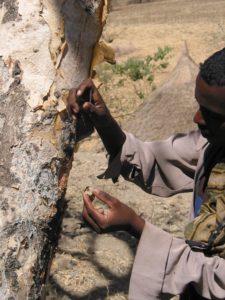(MENAFN- Brazil-Arab News Agency (ANBA))

São Paulo – From the trunk of trees native to the Middle East and North Africa a sap is tapped. This fluid, which hardens and becomes a resin, is used to manufacture the incense that is burned in religious celebrations and the homes of those who love its aroma. The sap is called frankincense and came to prominence in countries like Oman, which is called the on the United Nations World Heritage List. Pictured, one of the trees that produce frankincense in Oman.
No wonder Oman also used the tree as a symbol to open its pavilion in the world exhibition Expo 2020 Dubai that took place in the United Arab Emirates. The plants are also grown in other countries in the Middle East and Africa like Ethiopia, Sudan and Somalia .

In Ethiopia, traditional sapping methods are used
They belong to different species from the same genus, Boswellia.“The one that grows in the Middle East , which probably has the one with the more ancient or classic exploration, is Boswellia sacra. But the main source of incense nowadays is Boswellia papyrifera that grows in different countries in Africa,” Peter Groenendyk, professor at the Department of Plant Biology in the State University of Campinas (Unicamp), told ANBA.
Traditional sapping methods are used in countries like Ethiopia, a country Groenendyk has visited. There he saw the use of Mngaf, a hatchet that opens small areas on the tree barks.“As a reaction to these injuries, the trees produce a sap to basically seal the injury. After drying, the resin is collected to be used as incense. I believe that extraction in other places is done similarly,” he explained, adding that some regions in Brazil have trees from the same family, Burseraceae, whose sap is collected in a similar manner.
Endangerment But the trees that produce the raw material of incense may disappear.“There is an imminent danger of 'commercial extinction' of the incense production, as we've shown in . And by that we mean that viability of the incense production and extraction from natural forest could not be economically viable anymore in the medium term, in some decades. We saw that the populations of Boswellia are declining and that this is a problem that takes place throughout the species distribution,” said Groenendyk, who has also article published in media outlets like .

Boswellia papyrifera is one of the species that produce frankincense
The harvesting is currently done in natural forests, as commercial plantations do not exist yet. At this point, the way the activity is done impacts the entire chain. The Ethiopians, for example, have rules for a careful exploitation, like not causing too many injuries on the same tree.
Furthermore, the researcher ponders that the resin extraction is not the main issue, as the loss of habitat and the conversion of forest to crops or grazing lands can be a larger threat. Such issues have reduced the populations of Boswellia sacra, the“original” incense species, in such a way that there is no more production in the Arabian Peninsula. The species has also been included as an endangered species on the list of the International Union for Conservation of Nature (IUCN), the researcher points out.

Before becoming the incense, frankincense is the sap extracted from trees in the Middle East and North Africa
In a message sent to his colleague Groenendyk, researcher Frans Bongers, who visited Oman earlier this year talked about what he saw in the country. Bongers visited several regions in the country to carry out a survey of the Boswellia and revealed that there are still sites with a good or reasonable number of trees. There are places where these plants become food for camels. But in more remote areas where the access is more difficult, there are still seemingly healthy trees. But the researcher says that the resin extraction is still not careful enough, which can affect the plant populations.
Ancient trade The beginning of the use of the resin for manufacturing incense is unclear, but the activity is at least millennial.“It was already used in classical times and there were caravans of incense coming from the Arabian Peninsula to Greece and Rome,” the researcher says, pointing out that there is another record in the Bible, which mentions incense as one of the gifts from the Magi to baby Jesus.
What is certain is that the resin is economically and socially important in the countries that manufacture it.“For incense harvesters and local populations, it is a major source of income support. Frankincense is used in the production of cosmetics and perfumes, as well as religious and cultural rituals, like the coffee ceremony,” the researcher stressed.
In Brazil some companies import the resin to manufacture incenses, as is the case of Milagros , which produces 35 types of incense from resins of different origins, including Arab countries like Oman, Sudan and Somalia.
Translated by Guilherme Miranda
Frans Bongers
The post appeared first on .
MENAFN26092022000213011057ID1104927184
Legal Disclaimer:
MENAFN provides the information “as is” without warranty of any kind. We do not accept any responsibility or liability for the accuracy, content, images, videos, licenses, completeness, legality, or reliability of the information contained in this article. If you have any complaints or copyright issues related to this article, kindly contact the provider above.